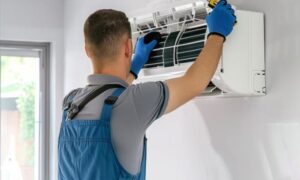Have you ever taken a moment to consider the level of air purity within your own home? It’s a topic that often goes unnoticed by most people, but for individuals with asthma or respiratory conditions, it’s definitely worth pondering.
Various pollutants, such as dust, dander, volatile organic compounds (VOCs), pollen, mold, smoke, and dust mites, can significantly impact the health of you and your family. The quality of indoor air can be influenced by factors like your geographical location, the design of your home’s ventilation system, and whether or not you have carpets.
One of the most effective methods for enhancing indoor air quality is through the use of air conditioning, as it greatly improves ventilation and airflow within the home. You can also check out premium quality Airton Climatiseur at discounted rates with Code Promo Airton 2023.
What causes Poor Indoor Air Quality?
Several factors can contribute to poor indoor air quality.
Here are some common causes:
Inadequate ventilation:
Insufficient airflow or lack of fresh outdoor air entering the indoor space can lead to a buildup of pollutants. Without proper ventilation, indoor pollutants can accumulate and affect air quality.
Various sources within a building can release pollutants into the air. These may include chemicals from cleaning products, volatile organic compounds (VOCs) emitted by paints, solvents, and furniture, tobacco smoke, pet dander, dust mites, mold spores, and pollen.
Poorly maintained HVAC systems:
Maintaining optimal indoor air quality heavily relies on the performance of heating, ventilation, and air conditioning (HVAC) systems. If these systems are not regularly cleaned and maintained, they can become a source of pollutants or fail to effectively filter and distribute clean air.
Construction materials and furnishings:
Some building materials, such as asbestos, lead-based paint, or formaldehyde-containing products, can release harmful substances into the air. Similarly, certain furniture, carpets, or upholstery may emit VOCs or other chemicals that impact air quality.
Moisture and dampness:
Excessive moisture in a building can promote the growth of mold and mildew, which release spores into the air and contribute to poor air quality. Leaks, water damage, and high humidity levels can all lead to moisture-related issues.
Outdoor pollution:
Poor outdoor air quality can also impact indoor air quality, especially in areas with high levels of pollution. Pollutants from traffic, industrial emissions, or nearby sources can infiltrate indoor spaces.
It’s important to identify and address these factors to improve indoor air quality and create a healthier living environment. Regular maintenance, proper ventilation, use of air purifiers, and reducing exposure to pollutants can all help mitigate the effects of poor indoor air quality.
How is Indoor Air Quality Measured?
Indoor air quality can be tested and measured through various methods to assess the presence and concentration of pollutants.
Here are some common techniques used for indoor air quality testing:
Air Sampling:
Air sampling encompasses the process of gathering indoor air samples and subjecting them to laboratory analysis. Various methods are available for air sampling, including grab sampling, integrated sampling, and real-time monitoring. Grab sampling involves collecting a single air sample at a specific moment, while integrated sampling involves collecting samples over a specific duration. Real-time monitoring, on the other hand, entails continuous monitoring of air quality. The collected air samples can be analyzed in the laboratory to identify and quantify different pollutants, such as particulate matter, volatile organic compounds (VOCs), carbon monoxide, carbon dioxide, mold spores, and allergens.
Physical Measurements:
Instruments can be used to measure specific parameters that affect air quality. For example, devices such as particle counters can measure the number and size distribution of airborne particles. Carbon monoxide (CO) detectors can detect and quantify the presence of CO gas, while carbon dioxide (CO2) monitors can measure the CO2 levels in indoor air. Humidity and temperature sensors can also provide information about the indoor environment.
Indoor Air Quality Index (IAQI):
The IAQI is a numerical scale used to assess and communicate the overall air quality in a particular space. It takes into account multiple parameters such as levels of pollutants, temperature, humidity, and other factors. By combining and weighing these factors, an IAQI value is calculated, providing an indication of the air quality level ranging from good to poor.
Visual Inspections:
Visual inspections are conducted to identify signs of mold growth, water damage, or other visible issues that may impact air quality. Inspectors may check ventilation systems, HVAC filters, and building materials for any signs of contamination or pollutants.
Occupant Surveys and Symptom Assessments:
Surveys and questionnaires can be administered to occupants to gather subjective information about their experience with indoor air quality. These surveys may include questions about symptoms (such as headaches or respiratory issues) and perceived air quality.
It’s important to note that professional testing and assessment may be required for comprehensive and accurate results. Qualified experts or indoor air quality professionals can provide guidance on appropriate testing methods based on specific concerns or requirements.
How Air Conditioning Improves Indoor Air Quality?
Air conditioning plays a significant role in improving indoor air quality through several mechanisms.
Here’s how air conditioning systems contribute to enhancing the quality of indoor air:
Filtration:
Air conditioning systems are equipped with air filters that capture and remove airborne particles from the circulating air. These filters can trap dust, pollen, pet dander, mold spores, and other pollutants, preventing them from recirculating throughout the space. It helps to improve the overall cleanliness of the air.
Ventilation:
Air conditioning systems provide controlled ventilation by bringing in fresh outdoor air and removing stale indoor air. This exchange of air helps dilute indoor pollutants, ensuring a constant supply of oxygen and reducing the buildup of contaminants.
Humidity Control:
Air conditioning units have the ability to regulate and maintain optimal humidity levels. By controlling excessive humidity, they discourage the growth of mold, mildew, and dust mites, which thrive in damp conditions. Maintaining proper humidity levels can also improve respiratory comfort and reduce the risk of respiratory infections.
Temperature Regulation:
Air conditioning systems effectively regulate and sustain a pleasant indoor temperature. This capability assists in mitigating the concentration and volatility of specific indoor pollutants. For instance, elevated temperatures can trigger the increased release of volatile organic compounds (VOCs) from various sources like building materials, furnishings, and cleaning products. By maintaining temperatures within an appropriate range, air conditioning helps minimize the emission of these pollutants.
Removal of Odors:
Air conditioning units can help eliminate or reduce unpleasant odors in indoor spaces. The filtration process and ventilation capabilities of air conditioning systems can effectively remove odorous particles and exhaust them outside.
To maximize the air quality benefits of air conditioning, it’s important to regularly clean and maintain the system. This includes replacing or cleaning air filters as recommended by the manufacturer to ensure optimal filtration efficiency. Additionally, scheduling routine inspections and maintenance by professionals can help identify and address any issues that may affect the performance of the air conditioning system and its impact on indoor air quality.
Conclusion:
Air conditioning systems significantly contribute to improving indoor air quality. Through the filtration of airborne particles, controlled ventilation, humidity control, temperature regulation, and odor removal capabilities, air conditioning helps create a cleaner and healthier indoor environment. Avail discount with Code Promo Airton 2023 to maximize your budget whilst buying Clim Airton. By investing in and maintaining air conditioning systems, individuals can enjoy the benefits of improved air quality and a more comfortable living space.


































